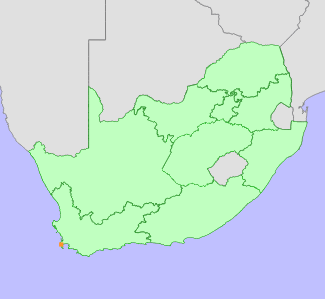|
Scientific Name | Serruria collina Salisb. ex Knight |
Higher Classification | Dicotyledons |
Family | PROTEACEAE |
Synonyms | Serruria flagellaris R.Br. |
Common Names | Lost Spiderhead (e) |
National Status |
Status and Criteria | Endangered B1ab(iii)+2ab(iii) |
Assessment Date | 2020/04/11 |
Assessor(s) | A.G. Rebelo, H. Mtshali & L. von Staden |
Justification | Serruria collina has a highly restricted distribution range, with an extent of occurrence (EOO) of 129 km², and an area of occupancy (AOO) of 32 km². It is known from four locations, and there is a continuing degradation of habitat due to alien invasive plants. It therefore qualifies for listing as Endangered under criterion B. |
Distribution |
Endemism | South African endemic |
Provincial distribution | Western Cape |
Range | This species has a very restricted distribution range on the Cape Peninsula, in the Western Cape Province, South Africa. |
Habitat and Ecology |
Major system | Terrestrial |
Major habitats | Peninsula Sandstone Fynbos |
Description | It grows in sandstone soils, at 100-600 m. It is a long-lived species, and survives fires by resprouting from underground boles or rootstocks. Seeds are released after ripening, and dispersed by ants to their underground nests, where they are protected from predation and fire. It is pollinated by insects. |
Threats |
| Urban expansion is likely to have caused the loss of the two historically known subpopulations of this species. Most of its remaining habitat is protected within the Table Mountain National Park, however for subpopulations occurring outside the reserve there is gradual ongoing degradation of habitat due to invasive alien plant species with this threat particularly severe for the subpopulation occurring at Dido Valley. |
Population |
Two subpopulations were known in 1985 (Hall and Veldhuis 1985), and four in 1993 (Pool and Smuts 1993). Currently, it is known from four subpopulations, the largest is found at Rooikrans and consists of about 2000 plants. Two of the four known subpopulations are small, and it is estimated that the population numbers fewer than 4000 mature individuals. It continues to decline as a result of habitat degradation due to invasive alien plants.
|
Population trend | Decreasing |
Conservation |
| It is protected at Karbonkelberg and Teeberg within the Table Mountain National Park. |
Assessment History |
Taxon assessed |
Status and Criteria |
Citation/Red List version | | Serruria collina Salisb. ex Knight | VU D2 | Raimondo et al. (2009) | | Serruria collina Salisb. ex Knight | Vulnerable | Hilton-Taylor (1996) | |
Bibliography |
Goldblatt, P. and Manning, J.C. 2000. Cape Plants: A conspectus of the Cape Flora of South Africa. Strelitzia 9. National Botanical Institute, Cape Town.
Hall, A.V. and Veldhuis, R.N.J. 1985. South Arican red data book: Plants - Fynbos and Karoo biomes. South African National Scientific Programmes Report 117. CSIR, Pretoria.
Helme, N.A. and Trinder-Smith, T.H. 2006. The endemic flora of the Cape Peninsula, South Africa. South African Journal of Botany 72(2):205-210.
Hilton-Taylor, C. 1996. Red data list of southern African plants. Strelitzia 4. South African National Botanical Institute, Pretoria.
Pool, R. and Smuts, L.M. 1993. Rare and threatened Proteaceae reports. Vol. 2. Cape Nature Conservation Unpublished Internal Report 10.
Pooley, E. 1994. Exciting find of Dahlgrenodendron natalense, the Natal quince. PlantLife 11:4-5.
Raimondo, D., von Staden, L., Foden, W., Victor, J.E., Helme, N.A., Turner, R.C., Kamundi, D.A. and Manyama, P.A. 2009. Red List of South African Plants. Strelitzia 25. South African National Biodiversity Institute, Pretoria.
Rebelo, T. 2001. Sasol Proteas: A field guide to the proteas of southern Africa. (2nd ed.). Fernwood Press, Vlaeberg, Cape Town.
|
Citation |
| Rebelo, A.G., Mtshali, H. & von Staden, L. 2020. Serruria collina Salisb. ex Knight. National Assessment: Red List of South African Plants version 2024.1. Accessed on 2025/12/02 |
 Comment on this assessment
Comment on this assessment

